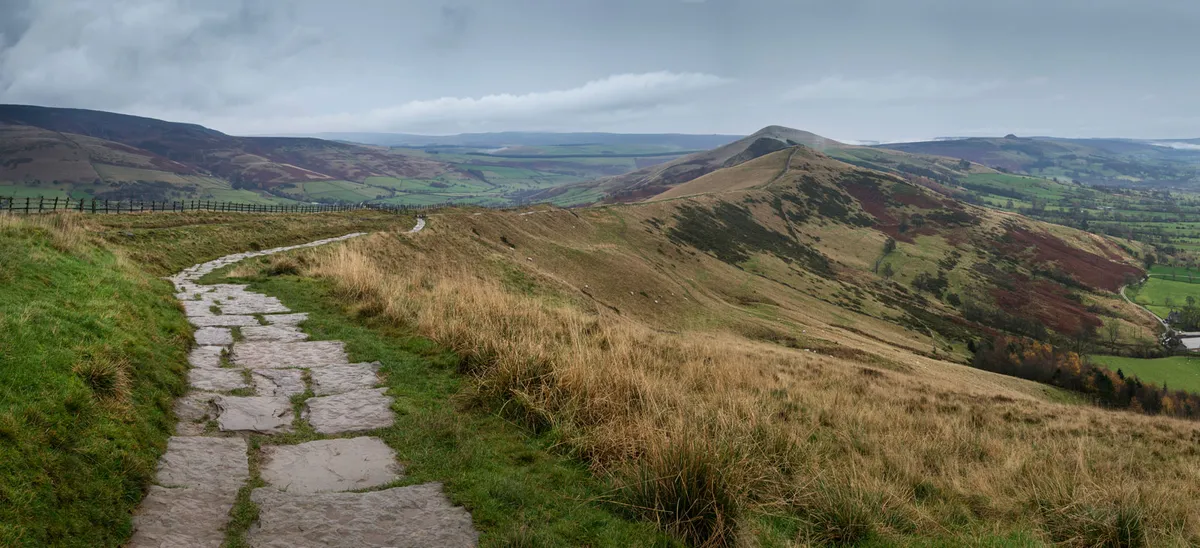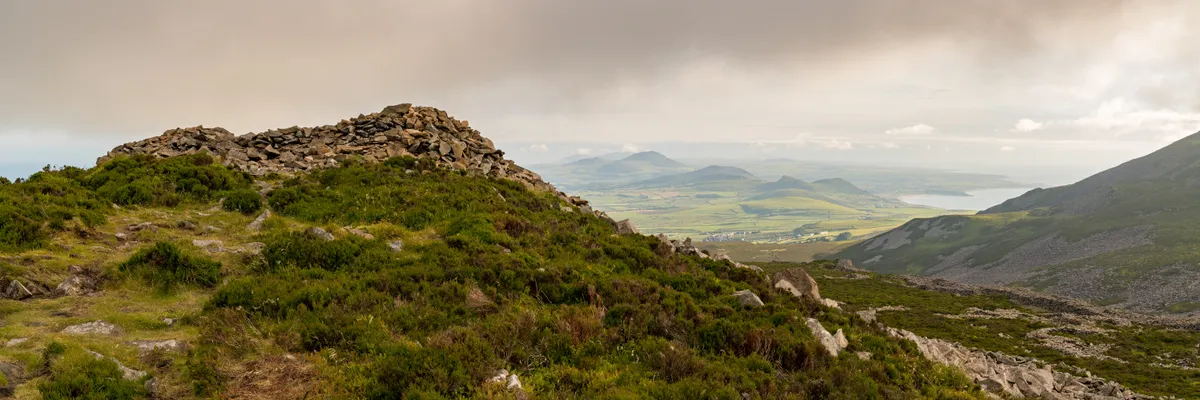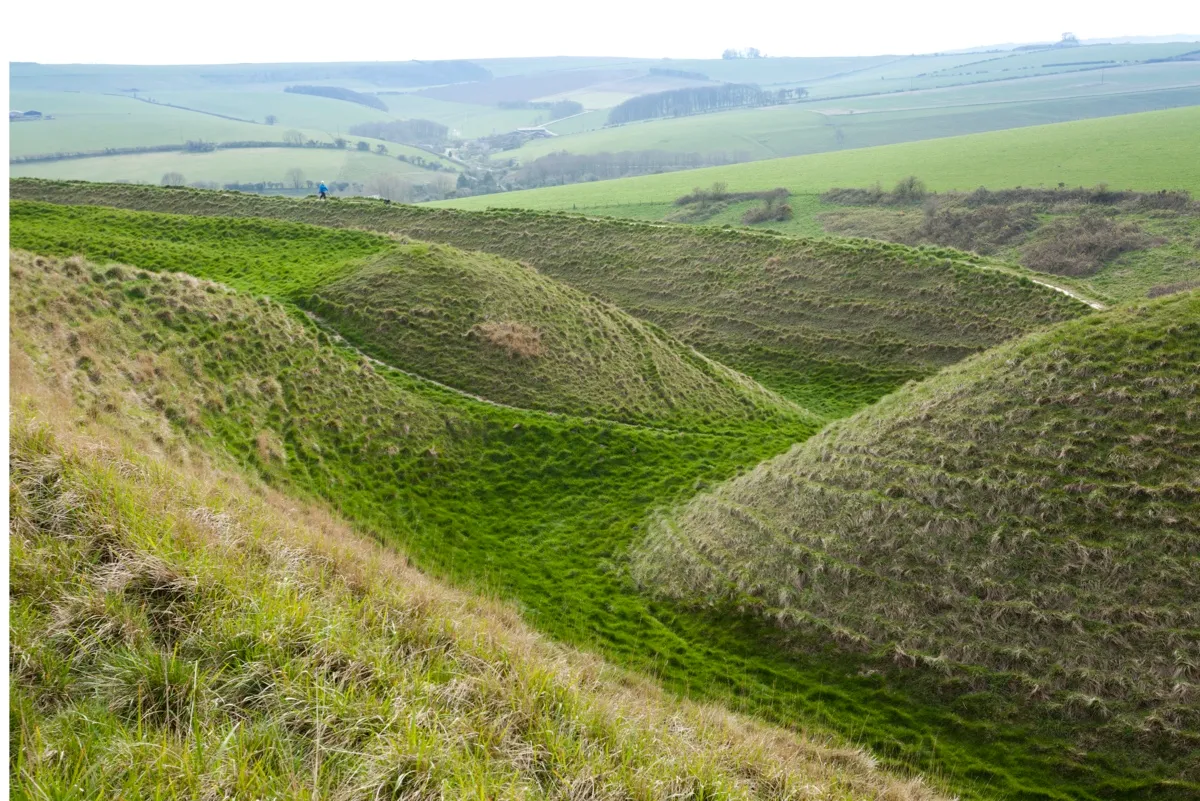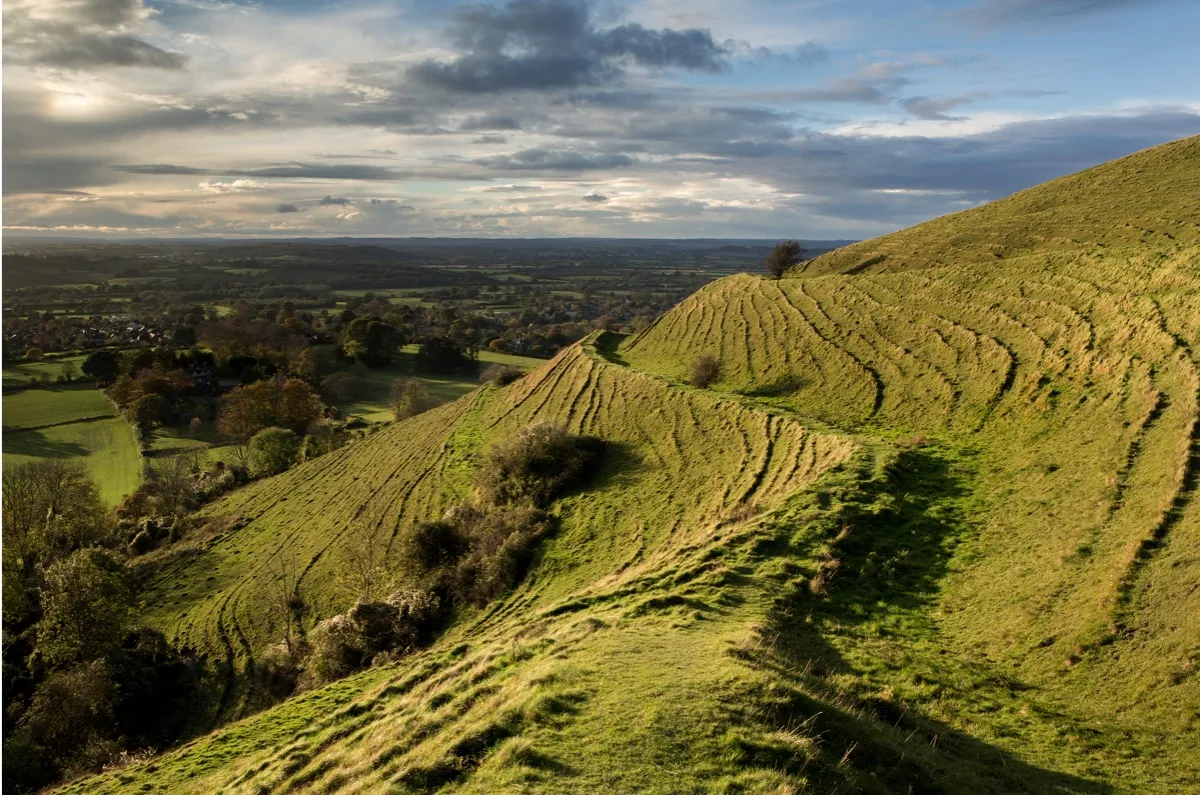You can get a hair-raising feeling of closeness to the past as you stand on the airy ramparts of Mam Tor, the 2,000-year-old hillfort that dominates the head of the Hope Valley in the Peak District.
Here is our guide on the history of British hillforts, looking at why these impressive structures were built and the best hillforts to visit in the UK
As you look east down the broad, tree-lined valley and north to the frowning heights of Kinder Scout, you are experiencing the same sense of dominance of the landscape as our ancestors who built the fort must have felt. This is especially true on a winter’s morning when mist fills the valleys and the earthworks are more sharply defined now the cloaking vegetation has died back.

Mam Tor is one of our most impressive hillforts, dating from the late Bronze to early Iron Age. Its embankments were built to abut onto the collapsed ‘shivering’ east face, thought to have formed part of the ancient defences.
Hillforts are little understood by most people, perhaps due to the militaristic name that the Victorians gave them. In fact, Mam Tor and many others seem to have been peaceful summer shielings, used by Celtic tribes to watch over their flocks. They would probably have been abandoned during winter months. But in others, such as Maiden Castle in Dorset and Danebury in Hampshire, there is evidence of an Asterix-style resistance to the Roman invaders.
How many hillforts are there in Britain?
Oxford University has published an online atlas of hillforts that doubles the number thought to exist. It has identified 4,147 hillforts in Britain and Ireland, where formerly the number was thought to be 2,000. There are 1,694 in Scotland; 1,224 in England (271 of which are in Northumberland); and 535 in Wales.

Why were hillforts built and who built them?
So how and why were these enigmatic structures built? The construction of a hillfort was a massive engineering and logistical task. It has been estimated it would take 150 men about four months to construct an eight-acre enclosure with a single bank and ditch, using nothing more than antler picks, wooden spades and woven baskets to transport the soil.
The method of construction is illustrated at Ladle Hill, an unfinished hillfort near Newbury, Berkshire. It isn’t known why it was abandoned but archaeologists are grateful, as it reveals how hillforts were built. It appears that gangs of workers were used to deepen and widen an initial encircling shallow ditch in sections.
Wooden palisades were often constructed first. Around these, embankments and gateways – often with intricate interlocking entrances such as those at Maiden Castle – were designed to give the defenders maximum advantage against potential attackers. Archaeologists still argue about the purpose of hillforts. They seem to be most common in disputed areas, such as the Welsh Marches and Northumberland, where in the College Valley, every hilltop seems to be crowned by a hillfort, each visible from its neighbour. This would support one theory – that they were the Iron Age equivalent of a nuclear deterrent, warning off opposing tribes or potential invaders.
When did hillforts stop being used?
When Roman commander Vespasian (later emperor) was sent to ‘subdue’ southern Britain in AD43, he attacked a string of about 20 hillforts. The Celts’ main weapon of defence appears to have been simple slingshots and spears. At Danebury, a collection of more than 10,000 slingshot stones were discovered and the skeletons of severely injured bodies have been found buried in ditches there and at Maiden Castle. One, in the Dorchester museum, has a Roman ballista bolt embedded in its backbone.
Many hillforts have hut circles in their interior, such as at Danebury, Tre’r Ceiri on the Llŷn Peninsula and Croft Ambrey in Herefordshire. The circular thatched huts were simple one-roomed homes made of wattle and daub. They would have been inhabited by people much like us, grumbling about their neighbours and the weather, or arguing over a missing sheep or pig. An open hearth stood at the centre of the hut; beds were made of straw covered in animal skin.
Iron Age economies were essentially pastoral, with livestock moved to the uplands in summer and down to the lowlands in winter for more sheltered grazing. Crops of emmer and spelt wheat, barley, rye and oats were grown in small, enclosed fields in the lowlands, and evidence has been found of storage pits for these grains in some hillforts.
The Roman Invasion signalled the beginning of the end for hillforts, although some, such as Hod Hill and Maiden Castle, were reused by the invaders as sites for forts or temples. Among the many things the Romans did for us was to construct roads, towns and an urban culture, and those Iron Age castles in the air were gradually abandoned to become the evocative, lonely monuments they are today.
As archaeologist James Forde-Johnson wrote in 1976: “Of all the earthworks that are such a notable feature of the landscape in England and Wales, few are more prominent or more striking than the hillforts built during the centuries before the Roman conquest.”
Britain's best hillforts to visit
1
Tre’r Ceiri, Llŷn Peninsula

The ruins of Tre'r Ceiri stand at more than 400m, on the lefthand peak – part of Yr Eifl ©GettySome of the drystone walls of Tre’r Ceiri – ‘The Town of the Giants’ – on the beautiful Llŷn peninsula still stand an impressive 15 feet high. The 150 hut circles within the ramparts could have housed up to 400 people. There are stunning views towards the Snowdonia hills. museum.wales
2
Mam Tor, Derbyshire

One of the largest (15 acres) and highest (1,695ft) hill forts in Britain, Mam Tor – or Shivering Mountain – commands the length the sylvan Hope Valley, with the brooding plateau of Kinder Scout to the north. One of the fabled' Wonders of the Peak', Mam Tor dates to the late Bronze Age.
3
Maiden Castle, Dorset

Surely the grandmother of all British hillforts, Maiden Castle, overlooking Dorchester, is certainly one of the biggest (it covers 47 acres), best-known and most impressive. Evidence has been found of an attack by the Romans, who later built a temple at its heart. One of the largest (15 acres) and highest (1,695ft) hill forts in Britain, Mam Tor – or Shivering Mountain – commands the length the sylvan Hope Valley, with the brooding plateau of Kinder Scout to the north. One of the fabled' Wonders of the Peak', Mam Tor dates to the late Bronze Age.
The fort slowly expanded over the centuries to become one of the largest in Europe, with space for dozens of roundhouses. The inner rampart of the fort would once have been topped with a stockade.
4
Hambledon and Hod Hills, Dorset

Hambledon is a magnificent multi-banked hillfort which winds sinuously around a chalk outlier overlooking Blackmoor Vale. It was built almost 5,000 years ago, using antler picks, and abandoned around 300BC. Its southern neighbour Hod Hill is only about half its age, and includes the only known example of a Roman fort superimposed on a native hillfort.nationaltrust.org.uk
5
Caer Caradoc, Shropshire

The legendary site of the Celtic leader Caractacus’s last stand against the invading Romans, Caer Caradoc dominates the beautiful Church Stretton valley in the heart of the Shropshire Hills. This six-acre hillfort encloses a spur of the 1,506-foot, volcanic crag-rimmed summit, where a shallow cave is said to have given Caractacus shelter.
• historicengland.org.uk
How to find hillforts in your local area
Seek out your local hillfort to share the feeling that people millennia ago surely experienced – that they were monarchs of all they surveyed. Visit: hillforts.arch.ox.ac.uk
